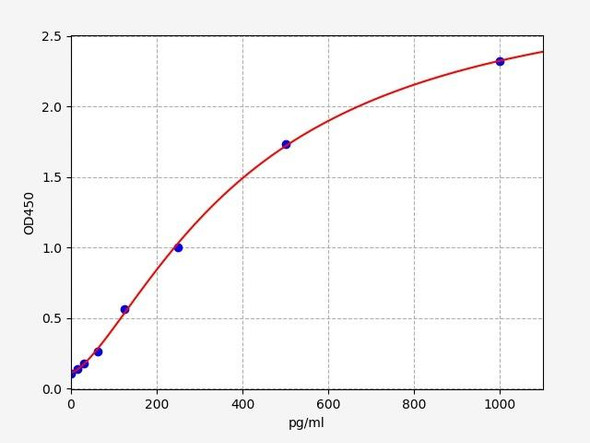Description
Human Amylin PharmaGenie ELISA Kit
| Product SKU: | SBRS0004 |
| Size: | 96T |
| Application: | Cross Reactivity: This ELISA kit shows no cross-reactivity with any of the cytokines tested: Ghrelin, Nesfatin, Angiotensin II, NPY and APC. |
| Uniprot: | P10997 |
| Gene ID: | 3375 |
| Gene Names: | IAPP |
| Synonyms: | Islet amyloid polypeptide (Amylin) (Diabetes-associated peptide) (DAP) (Insulinoma amyloid peptide) |
| Target Species: | Human, Mouse, Rat |
| Compatible Sample Types: | Cell Culture Supernatants, Serum |
| Design Principle: | Competition-based |
| Method of Detection: | Colorimetric |
| Quantitative/Semi-Quantitative: | Quantitative |
| Range: | 0.1-1,000 ng/ml |
| Sensitivity: | 0.62 ng/ml |
| Storage/Stability: | Standard, Biotinylated Amylin peptide, and Positive Control should be stored at -20°C after arrival. Avoid multiple freeze-thaws. The remaining kit components may be stored at 4°C. Opened Microplate Wells and antibody (Item N) may be stored for up to 1 month at 2 to 8°C. Return unused wells to the pouch containing desiccant pack and reseal along entire edge. |
- Pre-Coated 96-well Strip Microplate
- Wash Buffer
- Standard Peptide
- Assay Diluent(s)
- Biotinylated Peptide
- HRP-Streptavidin
- TMB One-Step Substrate
- Stop Solution
- Assay Diagram
- Positive Control Sample
- Capture Antibody
- Technical Manual
Other materials and equipment required:
The Assay Genie Human Amylin PharmaGenie ELISA Kit (SBRS0004) will require other equipment and materials to carry out the assay. Please see list below for further details.
- Distilled or deionized water
- Precision pipettes to deliver 2 ul to 1 ml volumes
- Adjustable 1-25 ml pipettes for reagent preparation
- 100 ml and 1 liter graduated cylinders
- Tubes to prepare standard and sample dilutions
- Orbital shaker
- Aluminum foil
- Saran Wrap
- Absorbent paper
- Microplate reader capable of measuring absorbance at 450nm
- SigmaPlot software (or other software that can perform four-parameter logistic regression models)
- Prepare all reagents, samples and standards as instructed.
- Add 100 ul detection antibody to each well.
- Incubate 1.5 h at RT or O/N at 4°C.
- Add 100 ul standard or sample to each well.
- Incubate 2.5 h at RT.
- Add 100 ul prepared streptavidin solution.
- Incubate 45 min at RT.
- Add 100 ul TMB One-Step Substrate Reagent to each well.
- Incubate 30 min at RT.
- Add 50 ul Stop Solution to each well.
- Read plate at 450 nm immediately.
Amylin, or Islet Amyloid Polypeptide (IAPP), is a 37-residue peptide hormone. It is cosecreted with insulin from the pancreatic beta-cells. Amylin plays a role in glycemic regulation by slowing gastric emptying and promoting satiety, thereby preventing post-prandial spikes in blood glucose levels. IAPP is processed from an 89-residue coding sequence. Proislet Amyloid Polypeptide is produced in the pancreatic beta cells (beta-cells) as a 67 amino acid, 7404 Dalton pro-peptide and undergoes post-translational modifications including protease cleavage to produce amylin. Insulin and IAPP are regulated by similar factors since they share a common regulatory promoter motif. The IAPP promoter is also activated by stimuli which do not affect insulin, such as tumor necrosis factor alpha and fatty acids. One of the defining features of Type 2 diabetes is insulin resistance. This is a condition wherein the body is unable to utilize insulin effectively, resulting in increased insulin production; since proinsulin and proIAPP are cosecreted, this results in an increase in the production of proIAPP as well. Amylin's metabolic function is well-characterized as an inhibitor of the appearance of nutrient in the plasma. It thus functions as a synergistic partner to insulin, with which it is cosecreted from pancreatic beta cells in response to meals. The overall effect is to slow the rate of appearance of glucose in the blood after eating; this is accomplished via coordinate slowing down gastric emptying, inhibition of digestive secretion [gastric acid, pancreatic enzymes, and bile ejection, and a resulting reduction in food intake. Appearance of new glucose in the blood is reduced by inhibiting secretion of the gluconeogenic hormone glucagon. These actions, which are mostly carried out via a glucose-sensitive part of the brain stem, the area postrema, may be over-ridden during hypoglycemia. They collectively reduce the total insulin demand.


